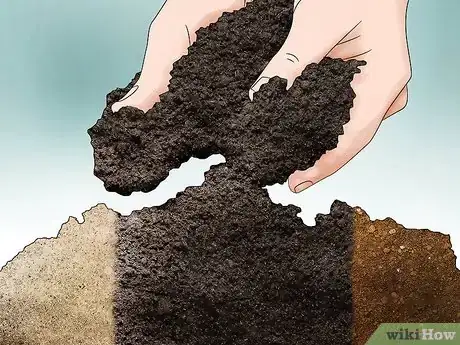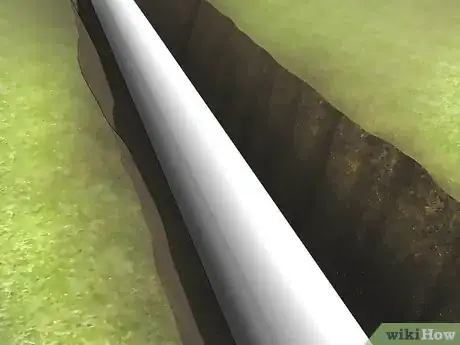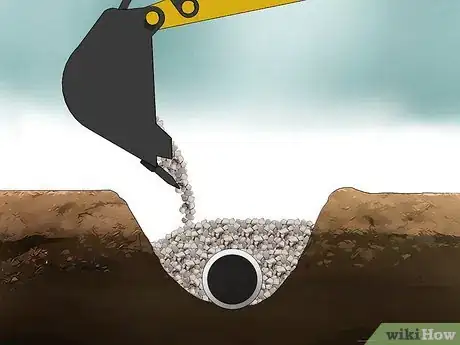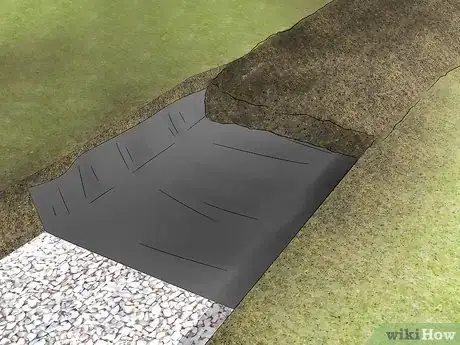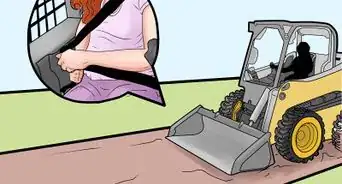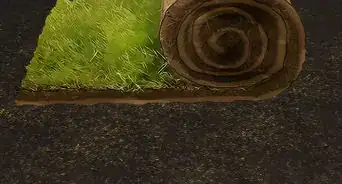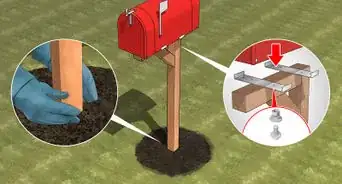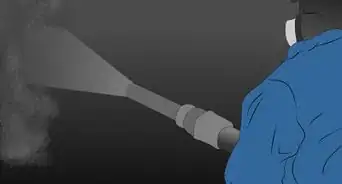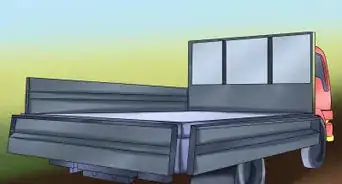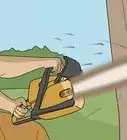This article was co-authored by Anthony "TC" Williams. Anthony "TC" Williams is a Professional Landscaper in Idaho. He is the President and Founder of Aqua Conservation Landscape & Irrigation, an Idaho Registered Landscape Business Entity. With over 21 years of landscaping experience, TC has worked on projects such as the Idaho Botanical Garden in Boise, Idaho. He is a Idaho Registered Contractor and a previously Licensed Irrigator in the State of Texas.
This article has been viewed 341,525 times.
For minor ditches or trenches, you can grab a shovel and start digging. Excavating a deep trench for sanitary sewer installations or other projects, however, requires special consideration. Plan the project in advance and learn how to complete each phase safely and successfully.
Steps
Planning the Excavation
-
1Call the local or government utility location service. Before you begin any digging project, call a utility location service. This will locate underground gas, electric, water, and communications pipes and cables in the area, to protect you from injury or liability in the event they are damaged.[1]
- In the US, by law, you must call Digline before beginning any digging project. Call 811 to contact a local call center. The service is completely free to use.
-
2Plan a route that causes minimal damage. Take your time in the planning phase to find a layout that meets your needs, avoids utility lines, and minimizes damage to valuable property. With careful planning, the materials you purchase should be sufficient to complete the trench, and you won't have to change your plan after you start digging.[2]
- Trees, shrubs and other plants may suffer injury or die if their roots are damaged in excavation. Driveways, sidewalks, and structures can collapse if they are undermined.
- Small plants, even turf grasses, can be removed and stored for replanting with proper care.
Advertisement -
3Determine the depth your project requires. The trench's depth requirements (for example, the required depth of a utility line) is a factor in choosing excavation equipment and other materials.
- Some plumbing systems are gravity operated, and require a slope so the waste or water will flow unaided to the discharge location. In this situation, you may find the trench will be deeper on one end than the other.
-
4Determine the type of soil you will be digging in. Sandy soils, loose stony soils, and wet, mucky material will make excavating a straight, deep ditch difficult and dangerous. In these scenarios, you may have to plan additional measures to complete your project successfully:[3]
- Shoring: This process uses a support structure for your ditch sides so they do not cave in and injure anyone, or undo the digging you have done before the project is complete. For example, a small excavation could use sheets of plywood supported by posts. Large excavations could use steel trench boxes or sheet piling. Anything deeper than 3 feet (0.91 m) should be shored up. Never enter a trench deeper than your waist if it is not shored up.
- De-watering: This removes the excess water from the soil to help stabilize it while working. This can be accomplished either with a well point system, or a sock pipe and mud-hog type diaphragm pump to remove the water as it seeps into the excavation.
- Benching the excavation: If you are digging in loose soil, a deep vertical trench wall is at risk of collapse. Benching involves digging the trench in steps or tiers instead, so the banks do not have to support more material than they are capable of. These benches are usually at intervals 2.5–3 feet (0.76–0.91 m) deep and twice as wide. They do take quite a bit of sidewall digging, which can require extensive area to complete. Keep in mind that it can still collapse the deeper the trench goes.
-
5Get the excavation equipment. Shovels, pickaxes, and other hand tools will suffice for minor excavations, but renting a mini excavator can save a lot of work on large jobs. Backhoes and even trackhoes may be needed if the project requires a very deep and/or long trench.
- Unless you are already experienced with these types of equipment, it may be cheaper and safer in the long run to hire a professional excavator.
Digging the Trench and Checking Depth
-
1Remove the topsoil. Excavate 10–20 centimeter (3.9–7.9 in) of soil, depending on the depth of the topsoil layer. Store the topsoil away from other spoil material to avoid contamination. Ensure that the topsoil heap does not exceed 1–1.5 meter (3.3–4.9 ft) in height to avoid compaction. For the same reason, either demarcate the topsoil heap or locate it away from frequent foot and vehicle traffic.
- If the topsoil is going to be stored for prolonged periods of time, over-seed with non-invasive grass species to reduce erosion, or cover it with a heavy tarp or plastic sheet.
- You may be charged fines if heavy soil or muddy water runs off your work site. Installing erosion control wattles or rolls can contain the water and prevent fines. These can be purchased at landscape and\or construction supply outlets.
-
2Begin the digging. Line your workers or equipment up with the ditch line, and start to dig. Be careful to observe soil conditions so that the trench embankments do not yield, allowing them to cave in.
-
3Dig your first cut to the appropriate depth. If the trench needs to be "benched" (excavated in steps), dig to the depth of the first bench. Otherwise, dig the first section to the full depth of the trench.
- If you need to bench, make subsequent entrenchments to the depth of each bench prior to digging deeper, so the banks of each bench will remain stable throughout the process.
-
4Keep the removed soil as far from the excavation as possible. Throw the spoil (the removed soil) far enough that it will not encumber you while working in and around the trench. This will also prevent the removed material from creating an overburdening of the trench's banks or sides, which would increase the risk of collapse.[4]
-
5Move along the length of your trench as each section is excavated to the required depth. Check the depth with a laser level or builder's level where the grade is critical to ensure the finished trench will not require adjustments.
- It is very difficult to 'walk' a piece of equipment back down an excavated trench. The heavy weight of the tools or machinery can increase the risk of collapsing trench walls. If you are operating equipment on your own, always keep it on undisturbed solid ground for as much of the process as possible.
-
6Check the completed trench. Once the entire trench has been excavated, recheck the depth throughout its length. Check the embankments for stability, and do any smoothing or finished grading of the trench bottom necessary to install the material the trench was dug for.
-
7Complete the project. For example, you may be removing an obsolete utility line, installing a new one, or installing a drainage system or sanitary sewer.
-
8Backfill the trench. If you have access to one, a gasoline operated plate tamp will enable you to pack the soil as it is replaced in the trench. For deep trenches, backfilling in lifts (layers) of about 8–10 inches (200–250 mm) and compacting the material as it is placed will reduce the amount of settling that will occur after the project is completed.
-
9Replace topsoil as soon as all the spoil has been back-filled. Roll out a heavy geotextile barrier over the soil first to prevent topsoil from mixing with gravel in the trench. Then replace the topsoil in the trench. This will ensure fertile soil and easy re-vegetation without having to resort to costly fertilizers.[5]
-
10Regrade and relandscape the area. Attend to surface conditions after connecting any utilities you have installed.
Expert Q&A
Did you know you can get expert answers for this article?
Unlock expert answers by supporting wikiHow
-
QuestionWhat is the maximum depth of the trench needed before battering is required?
 Anthony "TC" WilliamsAnthony "TC" Williams is a Professional Landscaper in Idaho. He is the President and Founder of Aqua Conservation Landscape & Irrigation, an Idaho Registered Landscape Business Entity. With over 21 years of landscaping experience, TC has worked on projects such as the Idaho Botanical Garden in Boise, Idaho. He is a Idaho Registered Contractor and a previously Licensed Irrigator in the State of Texas.
Anthony "TC" WilliamsAnthony "TC" Williams is a Professional Landscaper in Idaho. He is the President and Founder of Aqua Conservation Landscape & Irrigation, an Idaho Registered Landscape Business Entity. With over 21 years of landscaping experience, TC has worked on projects such as the Idaho Botanical Garden in Boise, Idaho. He is a Idaho Registered Contractor and a previously Licensed Irrigator in the State of Texas.
Experienced Landscaper
-
QuestionHow deep does a ditch have to be before I have to barricade the ditch off?
 Anthony "TC" WilliamsAnthony "TC" Williams is a Professional Landscaper in Idaho. He is the President and Founder of Aqua Conservation Landscape & Irrigation, an Idaho Registered Landscape Business Entity. With over 21 years of landscaping experience, TC has worked on projects such as the Idaho Botanical Garden in Boise, Idaho. He is a Idaho Registered Contractor and a previously Licensed Irrigator in the State of Texas.
Anthony "TC" WilliamsAnthony "TC" Williams is a Professional Landscaper in Idaho. He is the President and Founder of Aqua Conservation Landscape & Irrigation, an Idaho Registered Landscape Business Entity. With over 21 years of landscaping experience, TC has worked on projects such as the Idaho Botanical Garden in Boise, Idaho. He is a Idaho Registered Contractor and a previously Licensed Irrigator in the State of Texas.
Experienced Landscaper
-
QuestionWhat is the minimum distance traffic should be from the edge of a trench?
 Andrew Tintin RoyCommunity AnswerA good rule of thumb is to keep any traffic at least the distance away from the edge that the trench is deep, so if you have a one-meter trench, then keep traffic at least one meter away.
Andrew Tintin RoyCommunity AnswerA good rule of thumb is to keep any traffic at least the distance away from the edge that the trench is deep, so if you have a one-meter trench, then keep traffic at least one meter away.
Warnings
- Do not operate heavy equipment near the sides of a trench.⧼thumbs_response⧽
- Protect the trench with fencing, flagging, or other means to prevent someone from accidentally falling into it.⧼thumbs_response⧽
- Do not allow anyone into a trench that could cave in or collapse.⧼thumbs_response⧽
- Ensure that any trenches dug close to existing buildings do not undermine their foundations.⧼thumbs_response⧽
- If you are trenching near within close proximity of a railroad or historic landmark, Environmental Information Regulations must be submitted with permit.⧼thumbs_response⧽
- Provide a safe means for entering and exiting the trench. This may mean using a ladder or sloping bank for this purpose.⧼thumbs_response⧽
- Do not do any excavating without having underground utilities located prior to beginning.⧼thumbs_response⧽
Things You'll Need
- Tools or equipment for digging.
- Tools for laying out the trench, such as measuring tape, hammer, wooden stakes, or flags.
- A builder's level or laser level for determining the elevation of the trench.
References
- ↑ http://call811.com/before-you-dig/do-i-really-need-call
- ↑ https://www.osha.gov/Publications/osha2226.pdf
- ↑ https://www.osha.gov/Publications/osha2226.pdf
- ↑ https://www.ingaa.org/File.aspx?id=18983&v=1721599c
- ↑ http://www.hamiltontn.gov/pdf/WaterQuality/bmps/5.3ge.pdf
- http://www.osha.gov/SLTC/trenchingexcavation/index.html
About This Article
Excavating a small trench is relatively easy and only requires a shovel and pickaxe. However, bigger excavations require more equipment, so it may be best to call in professionals. Before you excavate a trench, you’ll need to call a utility location service to make sure you don’t run into any pipes or underground electric lines. Then, you'll want to rent a mini-excavator, a plate tamp operator, and a backhoe if your hole is going to be very deep. You’ll need to remove the topsoil layer and start digging. Once your trench is complete, you'll need to backfill the hole, then replace the topsoil so plants can grow on top. To determine what type of soil you’re digging in, read more from our Landscaping co-author!



